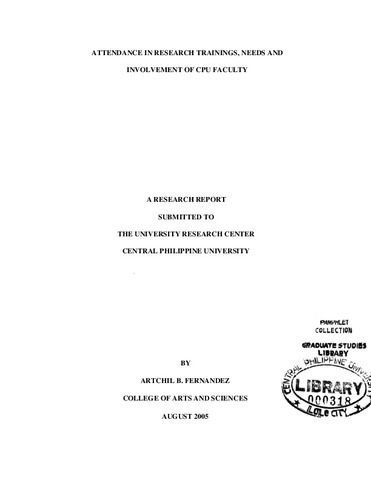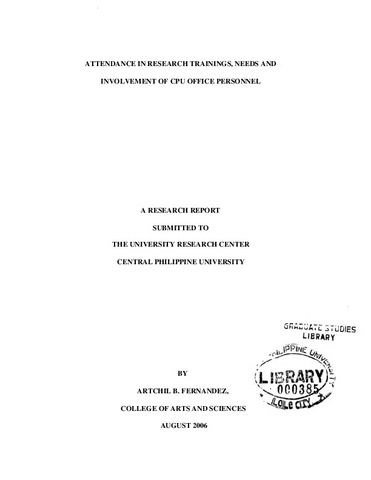The level of satisfaction of the secondary customers of Central Philippine University in school year 2005-2006 and the possibility of sending return customers to the university

Page views
782Date
2005-10Author
Share
Metadata
Show full item record
Abstract
This survey-correlational study attempted to analyze the factors influencing the satisfaction of the secondary customers of Central Philippine University and the possibility of sending secondary customers to the university. This study likewise determined percentages, differences, predictive significance of the variables, and the direction and significance of the relationship between variables. Data for this investigation were gathered from the 400 parents of students enrolled in the different colleges and departments of the University for school year 2005-2006, using an eleven section researcher-made data gathering instrument. The instrument was face validated, pilot tested and revised using factor analysis via Statistical Package for Social Sciences (SPSS) 10.00. Data gathered were presented using percentages, means and standard deviations, and analyzed using, stepwise multiple regression analysis and pearson’s product moment correlation coefficient. The alpha level for inferential statistic was set at .05. Results of the investigation revealed that the participants are well informed about the admission and enrollment procedure and consider the procedure easy. Their level of knowledge about tuition fees was high but considered the tuition and fees high. They are knowledgeable about billing practices and consider these practices advantageous to parents. Generally, they are moderately familiar with the instructional effectiveness and perceive academic instruction to be effective. They are familiar with and view the University’s grading system to be efficient. They are familiar with the educational climate of the University and believe it is conducive to learning. They are aware that their children’s are safe and secure in the University. They are moderately familiar of he University’s support services and consider these services adequate. They are satisfied with the University’s services and are certain to send return customers to the University. Age was found to be significantly related to grading system and safety and security and number of children enrolled at CPU was found significantly related to tuition and fees. There are five predictors for customer satisfaction and two for return customers. The two dependent variables are significantly related.
Description
Abstract only
Suggested Citation
Aberia, H. D. (2005). The level of satisfaction of the secondary customers of Central Philippine University in school-year 2005-2006 and the possibility of sending return customers to the university (Research report). Jaro, Iloilo City : University Research Center, Central Philippine University.
Type
Technical ReportSubject(s)
Shelf Location
GSL 378. 242 Ab37
Physical Description
v, 173 leaves
Collections
- Research reports [42]
- Research reports [167]
Related items
Showing items related by title, author, creator and subject.
-
Perceived sources and levels of stress among Central Philippine University employees
Alibogha, Salex E.; Concepcion, Ester L.; Querol, Faith Leila A. (Central Philippine University, 2003-09)A study on the perceived sources and levels of stress was conducted among 151 faculty and staff at Central Philippine University for school year 1999-2000. The Social Readjustment Rating Scale (Holmes & Rahe, 1967) was ... -
Attendance in research trainings, needs and involvement of CPU faculty
Fernandez, Artchil B. (Central Philippine University, 2005-08)The study was conducted mainly to determine the attendance in research trainings, needs and research involvement of CPU faculty. It utilized a one-shot survey design. Using Slovin’s formula, a sample of 206 faculty members ... -
Attendance in research trainings, needs and involvement of CPU office personnel
Fernandez, Artchil B. (Central Philippine University, 2006-08)The study was conducted mainly to determine the attendance in research trainings, needs and research involvement of CPU office personnel. It utilized a one-shot survey design. Using census technique (total enumeration), ...




